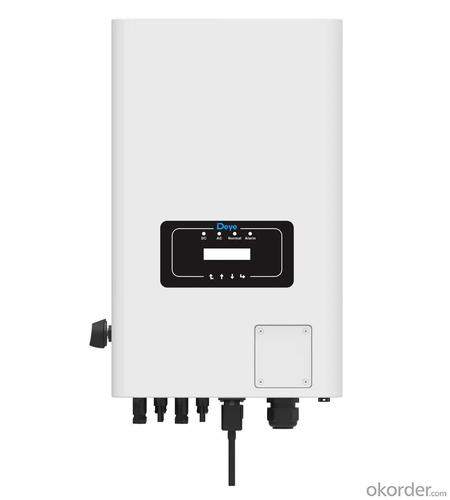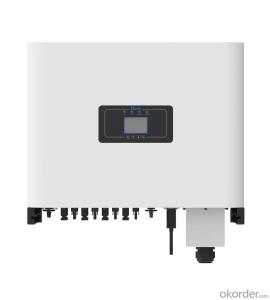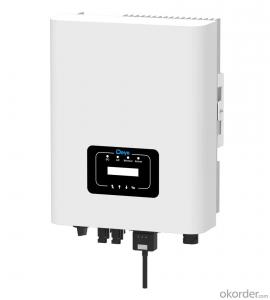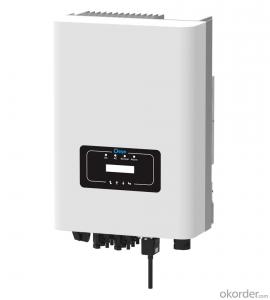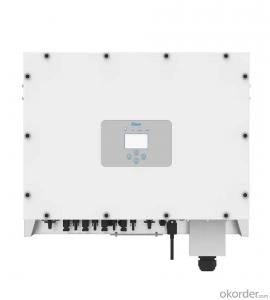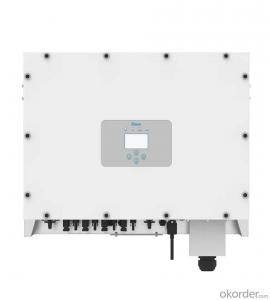Bosch Solar Inverter sun-30/33/36k-g04 | 30-36kw | Three Phase | 2 MPPT
- Loading Port:
- Ningbo
- Payment Terms:
- TT OR LC
- Min Order Qty:
- 100 pc
- Supply Capability:
- 5000 pc/month
OKorder Service Pledge
OKorder Financial Service
You Might Also Like
Specification
| Model | SUN-30K-G04 | SUN-33K-G04 | SUN-36K-G04 |
| Input Side | |||
| Max. DC Input Power (kW) | 39 | 42.9 | 46.8 |
| Max. DC Input Voltage (V) | 1000 | ||
| Start-up DC Input Voltage (V) | 250 | ||
| MPPT Operating Range (V) | 200~850 | ||
| Max. DC Input Current (A) | 40+40 | ||
| Max. Short Circuit Current (A) | 60+60 | ||
| Number of MPPT / Strings per MPPT | 2 / 4 | ||
| Output Side | |||
| Rated Output Power (kW) | 30 | 33 | 36 |
| Max. Active Power (kW) | 33 | 36.3 | 39.6 |
| Rated AC Grid Voltage (V) | 220 / 380, 230 / 400 | ||
| AC Grid Voltage Range (V) | 277Vac~460Vac (this may vary with grid standards) | ||
| Rated Grid Frequency (Hz) | 50 / 60 (Optional) | ||
| Operating Phase | Three phase | ||
| Rated AC Grid Output Current (A) | 43.5 | 47.8 | 52.2 |
| Max. AC Output Current (A) | 47.8 | 52.6 | 57.4 |
| Output Power Factor | 0.8 leading to 0.8 lagging | ||
| Grid Current THD | <3% | ||
| DC Injection Current (mA) | <0.5% | ||
| Grid Frequency Range | 47~52 or 57~62 (Optional) | ||
| Efficiency | |||
| Max. Efficiency | 98.6% | ||
| Euro Efficiency | 97.8% | ||
| MPPT Efficiency | >99% | ||
| Protection | |||
| DC Reverse-Polarity Protection | Yes | ||
| AC Short Circuit Protection | Yes | ||
| AC Output Overcurrent Protection | Yes | ||
| Output Overvoltage Protection | Yes | ||
| Insulation Resistance Protection | Yes | ||
| Ground Fault Monitoring | Yes | ||
| Anti-islanding Protection | Yes | ||
| Temperature Protection | Yes | ||
| Integrated DC Switch | Yes | ||
| Remote software upload | Yes | ||
| Remote change of operating parameters | Yes | ||
| Surge protection | DC Type II / AC Type II | ||
| General Data | |||
| Size (mm) | 362W×577H×215D | ||
| Weight (kg) | 25.5 | ||
| Topology | Transformerless | ||
| Internal Consumption | <1W (Night) | ||
| Running Temperature | -25~65℃ | ||
| Ingress Protection | IP65 | ||
| Noise Emission (Typical) | <45 dB | ||
| Cooling Concept | Smart cooling | ||
| Max. Operating Altitude Without Derating | 2000m | ||
| Designed Lifetime | >20 years | ||
| Grid Connection Standard | EN50549-1,VDE 0126-1-1 | ||
| Operating Surroundings Humidity | 0-100% | ||
| Safety EMC / Standard | IEC62109-1/-2,IEC61000-6-2,IEC61000-6-4 | ||
| Features | |||
| DC Connection | MC-4 mateable | ||
| AC Connection | IP65 rated plug | ||
| Display | LCD 1602 | ||
| Interface | RS485/RS232/Wifi/LAN | ||
This new series of three-phase output inverter has wider range of 30kw, 33kw, 36kw than the original series, at the same time still got two integrated MPPTs, allowing two-array to input from different roof orientations. In addition, it allows the system to be monitored and controlled remotely.
2 MPP tracker, Max. efficiency up to 98.6%
Zero export application, VSG application
String intelligent monitoring (optional)
Wide output voltage range
Anti-PID function (Optional)
- Q: Are there any government regulations or certifications for solar inverters?
- Yes, there are government regulations and certifications for solar inverters. In many countries, solar inverters need to comply with specific standards and regulations to ensure their safety, performance, and grid compatibility. Additionally, there are various certifications, such as UL, CE, and IEC, that solar inverters can obtain to demonstrate their compliance with the required standards. These regulations and certifications aim to promote the widespread adoption of reliable and efficient solar inverters in the renewable energy industry.
- Q: How does a solar inverter handle grid faults or disturbances?
- A solar inverter handles grid faults or disturbances by quickly detecting any changes in the grid voltage or frequency. When a fault or disturbance occurs, the inverter's protective features activate, causing it to disconnect from the grid momentarily. Once the fault or disturbance is resolved, the inverter automatically reconnects to the grid and resumes normal operation. This ensures the safety of the solar system and prevents any damage to the inverter or the grid.
- Q: How does the efficiency of a solar inverter affect the overall system performance?
- The efficiency of a solar inverter plays a crucial role in the overall system performance. A higher efficiency inverter converts a greater percentage of the solar energy into usable electricity, resulting in increased energy production. This means that a more efficient inverter allows the system to generate more power, maximizing the overall performance and output of the solar system. Additionally, a higher efficiency inverter reduces energy losses, which can lead to improved system reliability and cost-effectiveness. Therefore, the efficiency of a solar inverter directly impacts the overall performance and effectiveness of the entire solar energy system.
- Q: How does a solar inverter prevent reverse current flow?
- A solar inverter prevents reverse current flow by using a built-in feature called an anti-islanding protection mechanism. This mechanism detects when there is a loss of grid power and immediately shuts down the inverter to prevent any power from flowing back into the grid. This ensures the safety of utility workers who may be working on the grid during a power outage and also prevents damage to the solar panels and the inverter itself.
- Q: How does a solar inverter handle voltage phase imbalance in the grid?
- A solar inverter handles voltage phase imbalance in the grid by monitoring the phase angles of the grid voltage and adjusting its output accordingly. It continuously measures the phase imbalance and corrects it by injecting reactive power into the grid. This helps to balance the voltage across the different phases and maintain stable grid conditions.
- Q: How do you choose the right size solar inverter for your system?
- To choose the right size solar inverter for your system, you need to consider the total power output of your solar panels and the maximum power rating of the inverter. It is important to match the inverter's capacity with the maximum power output of your solar panels to ensure optimal performance and efficiency. Additionally, factors such as the type of system (off-grid or grid-tied) and future expansion plans should also be taken into account when determining the appropriate size of the solar inverter for your system.
- Q: Can a solar inverter be used with different types of grounding systems?
- Yes, a solar inverter can be used with different types of grounding systems. Solar inverters are designed to be compatible with various grounding configurations, including both grounded and ungrounded systems. However, it is important to ensure that the specific inverter model is compatible with the desired grounding system to ensure safe and optimal operation.
- Q: What is the maximum current output of a solar inverter?
- The maximum current output of a solar inverter depends on various factors such as the size and capacity of the inverter, the number and capacity of the solar panels connected to it, and the specific technology and design of the inverter. Generally, solar inverters have a maximum current output ranging from a few amps to several hundred amps, with larger commercial-scale inverters having higher current outputs compared to residential or smaller scale inverters. It is crucial to select an inverter that can handle the current requirements of the solar panel system to ensure optimal performance and safety.
- Q: Can a solar inverter be used with different AC voltages?
- No, a solar inverter cannot be used with different AC voltages. It is designed to convert the DC electricity generated by solar panels into a specific AC voltage, typically matching the grid voltage in the area. Using a solar inverter with a different AC voltage can result in damage to the inverter and potential safety hazards.
- Q: Can a solar inverter be used in a remote location without access to the grid?
- Yes, a solar inverter can be used in a remote location without access to the grid. Solar inverters are designed to convert the direct current (DC) generated by solar panels into the alternating current (AC) that can be used to power electrical devices. In remote locations, solar panels can be used to generate electricity independently, and the solar inverter can then convert this DC power into AC power for immediate use or to be stored in batteries for later use. This allows for the utilization of solar energy even in areas without grid connectivity.
Send your message to us
Bosch Solar Inverter sun-30/33/36k-g04 | 30-36kw | Three Phase | 2 MPPT
- Loading Port:
- Ningbo
- Payment Terms:
- TT OR LC
- Min Order Qty:
- 100 pc
- Supply Capability:
- 5000 pc/month
OKorder Service Pledge
OKorder Financial Service
Similar products
Hot products
Hot Searches
Related keywords




